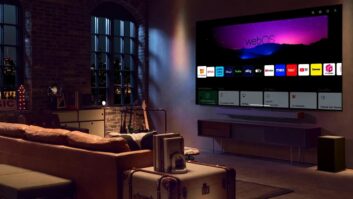El Segundo, Calif. — A new survey of television shoppers by iSuppli has found that U.S. consumers rate screen size as “far less important” than such factors as pricing, brand and picture quality.
The survey, which is part of iSuppli’s ConsumerTrak service and collected during the second quarter of 2008, said that screen size was only fifth on the list of considerations among consumers with annual incomes in a range from less than $25,000 to $99,999. The factor registered only single-digit percentages of those naming it as the primary consideration.
iSuppli said only 5.24 percent of those making less than $25,000 named size as the most important factor. Moving to higher income brackets, size was less critical, falling to sixth and seventh place, the market research firm found.
The study found price, picture quality and brand name as the top three considerations in making a TV set purchase, respectively, among consumers with incomes in the less-than-$25,000 to $99,999 income range.
iSuppli said the development “could have major ramifications for television brands.”
“Since the inception of the flat-panel television market, much of the focus has been on size, with suppliers focusing on making larger panels at lower costs,” stated Riddhi Patel, television principal analyst, for iSuppli.
“However, in recent times, attention has shifted to picture quality, with consumers placing increasing value on television front-of-screen performance. Television makers have responded to this trend by offering and promoting technologies that enhance video quality, including full high-definition resolution and the 120Hz refresh rate.”
Although important, Patel said picture quality is difficult to quantify, and that consumers are judging the criteria on their own perception in front of the screen, rather than relying on spec numbers. Therefore, she recommended manufacturers promote picture quality that is superior to the competition as much as their own strong brand names.
“If the consumer feels that for two different, but comparable, television sets, the picture quality is the same, then the brand with the lower price will win,” Patel said. “Because of this, television makers must pay close attention to consumers’ perceptions of video quality.”
Among lower-income-level U.S. consumers earning $25,000 a year or less, the price of the television was the biggest factor when selecting at set. However, with flat-panel television prices rapidly declining and the availability of more affordable products from premium set makers, a rising number of consumers in this income bracket cited the brand name as a top-buying criterion in the second quarter of 2008, Patel said.
For consumers making $200,000 and more, brand is the most important factor when choosing a television to buy, followed by picture quality. These consumers value the look of the television, including the finish, the color and the form factor. Because of this, product differentiation is key when addressing these consumers, according to the survey.
Consumers’ comfort level when buying televisions increases as the prices decline to $1,500 or less. More than 50 percent of televisions purchased in the United States in the second quarter had a selling price of less than $1,500, even those bought by consumers with incomes of $200,000 and more. This illustrates how price-conscious U.S. consumers are.
iSuppli said that consumers want the best value for their money and will not spend more if it’s not essential; however, there is always a small segment of early adopters who will pay extra to get a specific feature. These consumers are brand-conscious as well, it added.













